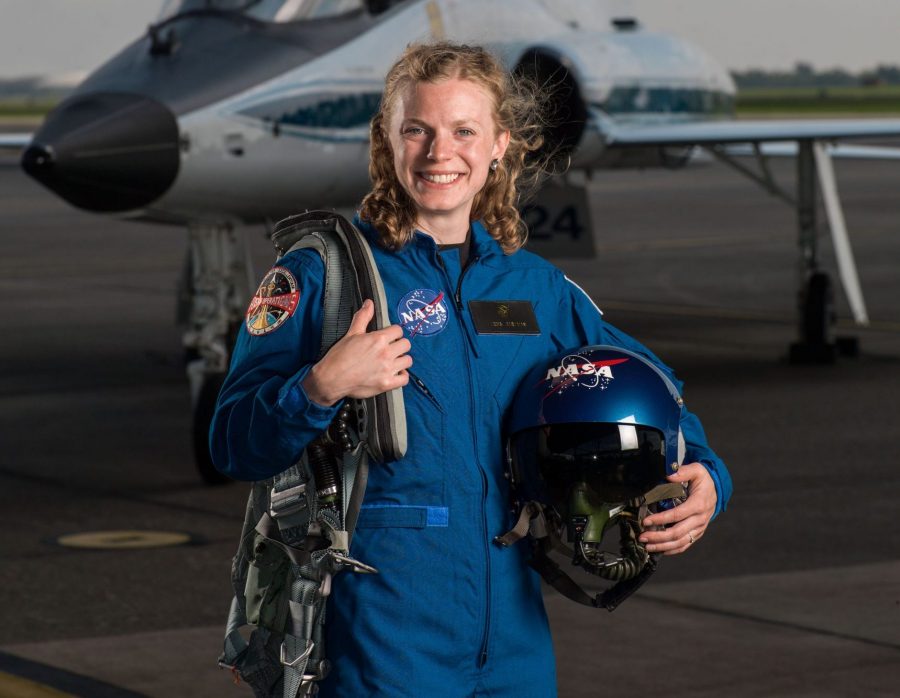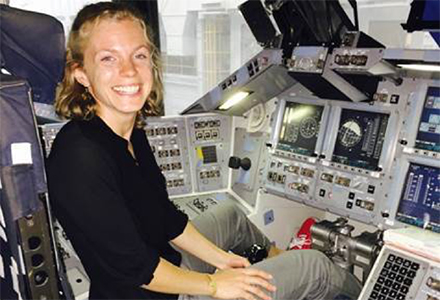Tar Heel Selected for NASA’s New Astronaut Class
Posted on June 9, 2017
NASA Astronaut Zena Cardman ’10 (’14 MS) (Photo by Robert Markowitz, NASA)
From the basalt lava fields of Hawaii to the vast white expanse of Antarctica, Zena Cardman ’10 has ventured to some of Earth’s most unique and remote places.
Now she’s setting her sights on the ultimate frontier — space. More than 18,300 people applied to be in NASA’s upcoming class of astronauts. NASA announced Wednesday that Cardman, who also earned her master’s from UNC in 2014, was among the top 12 accepted. She reports to NASA’s Johnson Space Center in August.
“It’s surreal,” Cardman said. “It still doesn’t quite feel real. I know that we’re all pinching ourselves a little bit. … The announcement itself, seeing how many people were excited about it, was humbling and really inspiring and I’m that much more excited to be part of this new adventure, this new NASA family moving forward.”
After two years of training, Cardman and the new astronaut candidates could be assigned to missions performing research on the International Space Station, launching from American soil on spacecraft built by commercial companies, and launching on deep space missions on NASA’s new Orion spacecraft and Space Launch System rocket.

Cardman reports to NASA’s Johnson Space Center in August. (Photo by NASA)
A decade before she walked down the hallway at Johnson Space Center for an interview at NASA, Cardman walked into Venable Hall, home to the marine sciences department on UNC-Chapel Hill’s campus. She fell in love with biology in high school under the tutelage of Emil Davis, one of her most influential teachers, but it wasn’t until she came to Carolina that Cardman discovered the wonders—and possibilities—of microbiology.
Cardman studies microorganisms to better understand life on early Earth. Billions of years ago, before plants or animals, before the rise of oxygen, single-celled Bacteria and Archaea were the only Earthlings.
“When we find really ancient metabolisms, they can tell us a lot about what might have been going on in early Earth,” Cardman said, who is pursuing her Ph.D. at Penn State.
Understanding those early-Earth organisms, she said, will be key in exploring and examining other planets.
“A lot of these environments where I work serve as analogs to environments either on early Earth or maybe another planet even,” she said. “Knowing how biology on Earth can make a living with very limited resources, or really environments that are stressful to an organism, helps us know what to look for when we go to another planet.”
Cardman graduated from Carolina in 2010 with a degree in biology, honors in poetry and minors in marine science, creative writing and chemistry. As a Carolina student, she collected data for the Palmer Long Term Ecological Research Network in Antarctica and explored modern stromatolites, living versions of our earliest fossil evidence for life on Earth, with the Pavilion Lake Research Project in Britsh Columbia.
“Everything from the Marine Sciences Department to the Biology Department and the creative writing program made such an impact on me and were so valuable,” Cardman said. “I feel like they’re family.”
More online
- “The 0.3 Percent,” by Mary Lide Parker ’11, available at Endeavors’ website.
- Zena Cardman’s NASA biography.
Three other Carolina alumni also have been astronauts:
- In 1967, when Dr. William Edgar Thornton ’52 signed on as the first astronaut from North Carolina, Apollo 11 had not yet landed on the moon. But Thornton was eager to explore the final frontier. “I am one of those individuals that is overloaded with the desire to go new places and see new things,” he said. “I have more curiosity than common sense.” As a medical student at UNC — he received his degree in 1963 — Thornton worked on the first anesthesia monitoring and developed the electrocardiac computer or automated EKG. By the time he stepped onto the space shuttle Challenger in August 1983 (at 54, the oldest astronaut at the time), he had made his mark with the invention of myriad monitoring devices and a gizmo for exercising in zero gravity referred to as “Thornton’s Revenge” for its demands on the body. For more, see the March/April 2012 Carolina Alumni Review.
- In 1969, Jerry Linenger was a teenager lying on a sand dune on the shoreline of Lake Huron, staring up at the moon. On a nearby picnic table sat a black-and-white TV powered by a portable generator. As news reports recounted Neil Armstrong’s dramatic first steps more than 200,000 miles above the Earth, Linenger looked into space and said, “I want to do that someday.” Two decades later, after earning two degrees from Carolina — a master’s in public health in 1989 and his doctorate in 1990 — he became an astronaut. His missions included an almost five-month stay aboard the Russian space station Mir. For more, see “The Man in the Mir” in the May/June 1998 Carolina Alumni Review.
- Capt. Charles E. Brady Jr. ’73, a native of North Carolina, studied premed at Carolina, completing the required premed courses in three years with a 4.0 grade point average and election to Phi Beta Kappa. He earned his medical degree from Duke University in 1975. In his initial career path of sports medicine, Brady worked at Iowa State University, then returned to UNC, working for three years under Dr. Joe DeWalt ’50. From UNC, Brady left for a sports medicine position at East Carolina University. Then, in 1986, he signed on as a Navy surgeon. In 1988, he was tapped for the Blue Angels, the Navy’s flight demonstration squadron. Two years later, he was selected by NASA to train as an astronaut and qualified as a mission specialist on shuttle flights, including on Columbia in 1996, at the time the longest space shuttle mission ever — a 16-day mission that orbited the Earth 271 times, covering 7 million miles in 405 hours. It was billed as a science mission, to conduct medical and physical experiments in preparation for work aboard the future space station. After his return, he said: “When you are hurtling around the Earth, you feel so connected. If you can find the button to push to keep on going, you would push it.” Brady died in July 2006 at age 54. For more, see Brady’s official NASA biography.
